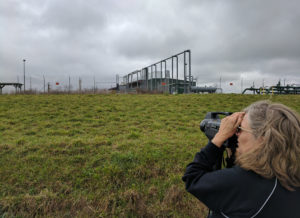By Phil Dickieson
I recently visited Westmoreland County, PA, to participate in a field trip with Earthworks Energy Field Investigators team members Leann Leiter and Sharon Wilson. Leann and Sharon were visiting the area on behalf of community members looking to record and document pollution from oil and gas operations with Earthworks’ state-of-the-art Optical Gas Imaging (OGI) camera.
The oil and gas industry and the government use OGI cameras to detect leaks—and so do we. Earthworks uses the same camera models they do, and we have certified camera operators. Earthworks staff travel to facilities that appear to be making little or no effort to rein in their pollution, and we use these videos to file official complaints with state and national regulators, and to help communities do the same.
Gillian’s Story
Upon arriving in Harrison City, PA, we met with Gillian Graber, founder and Executive Director of Protect PT, a local group working to protect residents of the Penn-Trafford school district (and beyond) from the harmful effects of oil and gas facilities.
Drawn to Westmoreland County by the mix of rural agricultural land and residential neighborhoods, Gillian hoped to raise her children in a safe community with good schools and clean air.
After settling down in the area, she learned of a recent local ordinance re-zoning local agricultural land. This zoning allowed industrial use of previously rural land, much of which sits adjacent to homes, schools, and parks. Gillian feared not only for her family’s health, but for the thousands of other area residents—so she founded ProtectPT, educating the local community and advocating for responsible and safe industry.
Driving around the county, we visited at a local resident with a compressor station across the street from his home. He told us about pollution so bad that just 45 minutes of exposure—less than the time it takes to cut the grass—could cause nausea. And it’s not that surprising. The facility is literally feet away from his front door and we filmed some horrifying emissions there. Can you imagine not being able to spend time in your own front yard?
Gillian’s story is not unique.
Earthworks Field Investigators have visited 1,127 facilities across the country, filed 120 complaints, and interviewed dozens of people. The team has documented stories and created a website with a map of OGI videos and complaints.
More than 12.6 million people in the US live within a half-mile of an oil and gas facility—and more and more of those people are coming face-to-face with health and safety risks. Oil and gas infrastructure is expanding around the world, which is why we visited sites in Mexico last fall.
So you might say Earthworks is gearing up for this fight. We’ve had successes so far—complaints that have resulted in real changes. And Earthworks receives more inquiries every day—folks desperately in need of real, visual, proof of the pollution they already feel and smell.
Getting Involved
Field Investigations are a powerful tool… but only as powerful as the community members that stand with us. If you live near oil and gas infrastructure that you suspect is emitting pollution, submit a request for Earthworks to film in your community.
If you know of a local organization fighting oil and gas infrastructure, reach out to them and let them know about our work.
And if you can, show your solidarity with a donation.
Your support helps real people facing real harm—your donation goes beyond purchasing a camera or paying for our team to travel to sites. You have the power to stop polluting companies in their tracks and bring clean air and peace of mind to real people.
Your Support Makes Our Work Possible
Earthworks helps families on the front lines of mining, drilling, and fracking. We use sound science to expose health, environmental, economic, social, and cultural impacts of mining and energy extraction. To support our efforts, please consider a tax-deductible donation today that will go toward our work reforming government policies, improving corporate practices, influencing investment decisions, and encouraging responsible materials sourcing and consumption.

